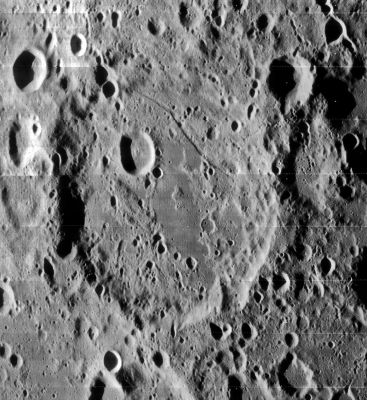Furnerius
Contents
Furnerius
|
Lat: 36.0°S, Long: 60.6°E, Diam: 135 km, Depth: 3.92 km, [/R%C3%BCkl%2069 Rükl: 69], pre-Nectarian |
Table of Contents

LOIV-184-H2 The prominent crater on the floor is Furnerius B, while the rille to its upper right is [/Rima%20Furnerius Rima Furnerius]. The larger of the two craters in the upper left of the frame is Furnerius C, with the smaller, but brighter, Furnerius A to its right. Several of the other features around the rim of Furnerius are named [/satellite%20feature satellite features].
Images
LPOD Photo Gallery Lunar Orbiter Images Apollo Images
Maps
([/LAC%20zone LAC zone] 115A4) USGS Digital Atlas PDF
Description
Description: Elger
([/IAU%20Directions IAU Directions]) FURNERIUS.--The fourth and most southerly component of the great meridional chain of walled-plains, commencing on the N. with [/Langrenus Langrenus]: a fine but irregular enclosure, about 80 miles in extreme length and much more in breadth. Its rampart is very lofty, and tolerably continuous on the N. and E., but on the other sides is interrupted by small craters and depressions. At peaks on the W. it attains a height of more than 11,000 feet above the interior, and there are other peaks rising nearly as high. There is a ring-plain (Furnerius B) with a central hill, on the W. side of the floor, and numerous craters and crater-pits in other parts of it. On the N.E. side of B there is a short cleft, on the E., a well-marked crater-row, and on the W. a long rill-valley. The very brilliant crater (Furnerius A) on the N.W. glacis is the origin of two fine light streaks, one extending S. for more than 100 miles, and the other in the opposite direction for a great distance.
Description: Wikipedia
Additional Information
- Depth data from [/Kurt%20Fisher%20crater%20depths Kurt Fisher database]
- Westfall, 2000: 3.92 km
- Cherrington, 1969: 3.35 km
- Satellite crater Furnerius C is on the [/ALPO%20list%20of%20bright%20ray%20craters ALPO list of bright ray craters].
- This would seem to be a misprint for Furnerius A, a fresh, young and bright crater just to the east of Furnerius C. In addition to being mentioned by Elger, Furnerius A is prominent enough to have served as a selenodetic control point. In the [/ULCN#ULCN_1994 1994 ULCN] its position is listed as 33.538°S/59.076°E. - JimMosher JimMosher
Nomenclature
- Named for Georges Furner (unkn-fl. 1643), a French mathematician. Little seems to be remembered about him.
- [/Whitaker Whitaker] believes the present crater may have been known to van Langren as Curtii (p. 195) or Ligni (p. 199).
- The name was introduced on [/Riccioli Riccioli]'s map, and has continued unchanged except that it was originally labeled Furnerius Soc. I, the Soc. I meaning "Society of Jesus" (see [/Nomenclature-Jesuits Nomenclature-Jesuits]).
- Hevelius evidently used the name Mons Paropamisus to refer to the bright nimbus of the modern Furnerius A and Snellius A.
The Headlights
- Furnerius A and nearby Stevinus A (a distinct pair of high-albedo ray craters) are sometimes called the Headlights, see page 20 in the 21st Century Atlas of the Moon by Charles Wood and Maurice Collins.
LPOD Articles
Fabulous Furnerius Fantastic Furnerius Four in a Row
Bibliography
This page has been edited 1 times. The last modification was made by - tychocrater tychocrater on Jun 13, 2009 3:24 pm - afx2u2